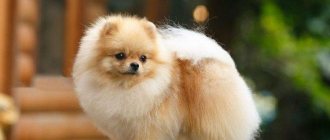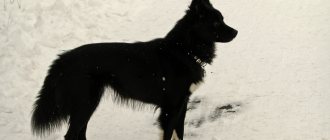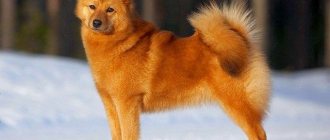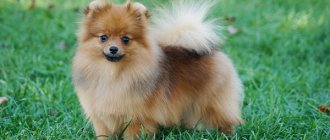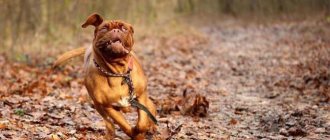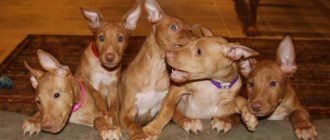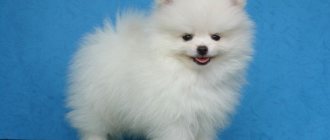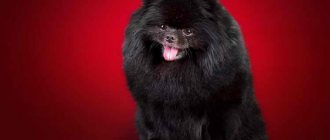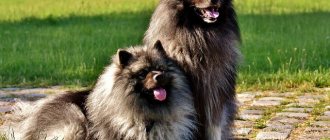| Origin: | Italy |
| Usage: | decorative dog |
| Color: | white; ginger |
| Dimensions: | Weight 3-4 kg. The height of the female is 25-28 cm, the height of the male is 27-30 cm |
| Lifespan: | 13-16 years old |
The Volpino Italiano or Italian Spitz is a playful, cheerful dog. The pet is unpretentious in care and maintenance, which allows even beginners to have one. The Italian Spitz is dependent on humans and has a hard time withstanding loneliness. With proper training, the dog will become an indispensable companion. Attachment to home and family is a distinctive feature of this breed.
Italian Spinone care and dog maintenance
This breed can be called relatively easy to care for.
- A dog's fur sheds twice a year. During this time, she is combed daily until the old fur is completely removed.
- The rest of the time, it is enough to brush the dog weekly and remove particularly tenacious burrs after a walk. This procedure is very simple, since the dog’s hard hair does not allow plant seeds to be retained for a long time - they eventually slide off and are discarded on their own.
- Droopy ears should be inspected weekly and cleaned if necessary. The eyes are examined every day, removing dried dark discharge. If inflammation of foreign bodies appears, as well as profuse purulent discharge, you should contact a veterinarian.
- Heavy and agile, spinones usually wear down their claws on their own.
- But their teeth can become overgrown with plaque if the dog constantly eats soft food. To clean your teeth, you can use toothpaste and a brush, or special bones and sticks such as Dental, as well as dry food with large granules, cartilage and large beef bones.
Spinone is an excellent dog for a country house or cottage. The city apartment is a bit cramped for her. The exception is when the owner likes to walk a lot and takes his dog with him everywhere. To limit movement around the site, if necessary, an enclosure will be required.
Since spinones do not have an undercoat, they will need to be insulated in cold regions.
But in general, these dogs behave well inside the house, rarely cause trouble for their owners and quickly learn to toilet outside. Therefore, they can be taken into the house in the evening or in cold weather.
Which owner is it suitable for?
Volpino Italiano is well suited for a person who is used to moving a lot and constantly being in action. The dog feels great when everything around is in dynamics. Although representatives of this breed are very small in size, they are certainly not designed to be carried on the arms.
The Italian Spitz is extremely inquisitive and loves long walks, communication, and learning about the world around him. Like any other type of Spitz, Volpino is definitely not suitable for phlegmatic and melancholic people. But for energetic people with an active lifestyle, this dog will become a real partner and devoted friend.
It will be useful for you to learn about why dogs bark, howl and lick their paws, how to remove the terrible smell from a dog’s mouth, how to teach a dog to brush its teeth, when it is necessary and how to trim a dog’s claws correctly, is it possible to keep dogs and cats together, are diapers necessary and diapers for dogs, as well as how to properly care for your pet while walking.
Care
If you are melancholic, then it will be difficult for you to get along with a dog.
Volpino's overflowing energy forces their owners to tirelessly pay attention to their pet, forgetting about themselves. Florentine Spitz dogs need frequent walks to help the dog feel good.
Moreover, the walk should be active - with running, jumping and other attributes of a sports lifestyle.
Advice! The dog will gladly support any of your endeavors. Frisbee and agility are ideal options for practicing with your pet. Know that if a dog begins to damage property in the apartment, it means he lacks physical activity.
You need to devote enough time to your pet’s appearance, and do this regularly, and not periodically. Monitoring the condition of the dog’s claws, fur, teeth, ears and eyes is mandatory:
Wool
The dog is combed with special combs or brushes twice a week (during the molting period - twice a day), using a slicker brush and a special comb. Bathing is carried out at least three times a month, followed by combing to prevent tangles with a special tool - a tangle cutter. Hair trimming is prohibited, with the exception of hairs near the claws of the paws. For slushy weather, buy your four-legged friend a water-repellent overall - this way his fur will get less dirty during a walk.
Teeth
For preventive purposes, special pressed tartar stones are recommended for dogs. Teeth brushing is done once every 2 days using a silicone brush and dog toothpaste.
Eyes
The Florentine Spitz is small in stature, so this breed suffers much more from dust getting in the eyes than larger dogs. A daily examination will allow you to notice vision problems in time, and if your dog has tear ducts, monitor his diet. Normally, there is no heavy discharge. For eye hygiene, use a tampon with herbal infusion.
White color
Claws
Claws are adjusted once every 10 days.
The Italian Spitz is a well-mannered and cultured dog. For walking, you can purchase a collar, which, most likely, will only be useful for your peace of mind. When choosing a model, focus on the quality of the material; the right solution would be a soft leather product that will not degrade the quality of the wool.
Socialization
Volpino Italiano is famous for its easy-going, friendly disposition, which allows it to be kept in a family with small children.
The dog will never hurt a child on purpose, but will treat him tenderly. A faithful companion in games and mischief, the Italian Volpino will become a good friend for a teenager. For educational purposes, this pet is ideal. He will teach the child care and kindness. The Florentine Spitz treats other pets, dogs or cats, as playmates.
How much do Volpino Italiano puppies cost?
The price for a small Italian Volpino varies from 50 thousand rubles to 200 thousand rubles. Price formation is influenced by factors such as the puppy’s gender, prospects, and pedigree. You can find advertisements for the sale of Italian Volpino puppies in the range of 3-15 thousand rubles. These are puppies with signs of rejection; they are not allowed for breeding and have no exhibition future. But as a pet, it is no worse than its titled relatives.
To select a purebred puppy, contact nurseries. Buying a puppy secondhand, through private advertisements, does not provide a guarantee of purebredness. Under the guise of an Italian Spitz Volpino, scammers can sell a dog of another breed. When contacting professional breeders, the future owner can be sure of the purebred Florentine Spitz. Accompanying documents - a puppy card, a certificate of vaccinations - a guarantee of the quality of the dog breed.
In Russia, Volpino is bred at the El Dolce Amico (Dear Friend) nursery, located in the Moscow region. https://volpino.club/
The Volpino Italiano is an unusual dog with a bright appearance and a cheerful disposition. Capable of becoming a friend and faithful companion to both elderly single people and families with small children. Playful and friendly, but at the same time unobtrusive, sensitive to the mood of its owners, the dog will bring joy to the house.
I like5I don't like
Origin story
Italian Volpino has been known since Roman times. The ancestor was the European Spitz, common in central Italy. At the end of the 19th century, Queen Victoria of England, making her next visit to Florence, brought this dog with her. Since then, another name for the breed has become common: Florentine Spitz.
Volpino was considered a sacred dog; she was idolized both in high society and in the poorer classes.
Thanks to its striking appearance and non-conflict disposition, the pet was a favorite of the royal family, and received the name “palace dog”.
Geographic nicknames
If you want to choose a name for your puppy that no other pet has, you can look at the euphonious names of Spanish cities:
- Madrid;
- Seville;
- Barcelona;
- Valencia;
- Malaga;
- Zaragoza;
- Murcia;
- Cordoba;
- Alicante;
- Vigo;
- Gijon;
- Vitoria;
- Granada;
- Oviedo;
- Sabadell;
- Cartagena;
- Badalona;
- Lanzada;
- Aguilas;
- Alaro;
- Altea;
- Alcoy;
- Albons;
- Arosh;
- Avila;
- Baena;
- Behar;
- Barro;
- Benisa;
- Broto;
- Blanes;
- Burgos;
- Cabra;
- Campo;
- Candas;
- Corea;
- Derio;
- Elch;
- Getcho;
- Holeta;
- Aro;
- Orche;
- Isla;
- Eamon;
- Lepe;
- Lerma;
- Llanes;
- Lleida;
- Lorca;
- Luces;
- Maro;
- Pego;
- Pusol;
- Reus;
- Requena;
- Company;
- Salamanca;
- Solares;
- Totana;
- Tredos;
- Viana;
- Safra;
- Mogan;
- Arona;
- Telde;
- Adeje;
- Mahon;
- Campos;
- Kostic;
- Deya;
- Selva;
- Sineu;
- Pina.
In the photo - Avila:
And now - an Italian selection:
- Rome;
- Naples;
- Milan;
- Palermo;
- Turin;
- Genoa;
- Bologna;
- Bari;
- Venice;
- Catania;
- Verona;
- Messina;
- Taranto;
- Prato;
- Trieste;
- Modena;
- Foggia;
- Cagliari;
- Rimini;
- Latina;
- Monza;
- Forli;
- Bergamo;
- Vicenza;
- Alghero;
- Aosta;
- Ancona;
- Asti;
- Bormio;
- Biela;
- Verese;
- Vatican;
- Vieste;
- Gaeta;
- Cagliari;
- Catania;
- Cuneo;
- Lecco;
- Lerici;
- Lecce;
- Loddy;
- Mantua;
- Olbia;
- Pavia;
- Pisa;
- Pompeii;
- Prato;
- Rovigo;
- Salerno;
- Ligure;
- Teramo;
- Tivoli;
- Tropea;
- Udine;
- Fori;
- Cesana.
Photo of Verona:
Description
The Italian Spinone (or Griffon, Wirehaired Pointer) is an ancient breed of dog originally from Italy.
These large animals have universal hunting qualities:
- During the hunt, they easily run through the swamp and rough terrain of the land.
- They are not at all afraid of ice water.
- They easily make their way into dense and thorny thickets of thorns.
Outside of hunting, he is a wonderful friend with a calm, easy-going character.
Peculiarities
The Griffon Italiano differs from other hounds in its unusually thick skin and thick, coarse hair, which reliably protects the animal hidden in the thorns from thorns.
There is no exact information about the origin of the breed, so it is believed that the dog has Roman or Eastern European roots. The possibility of a family connection with the wire-haired Italian Segugio cannot be ruled out.
Interesting fact
In Italian, the word "Spinone" means "thorn" or "thorn".
Distinctive features
Head
The head is oval in shape with sloping sides of the skull. The transition of the forehead to the muzzle is not sharp, but with a clearly visible vertical furrow. The muzzle is of pronounced length and looks square from the front.
Teeth
The teeth are powerful and well developed. In the middle of the lower jaw, the teeth are slightly curved. Bite – straight or “scissors”.
Ears
The ears are triangular in shape, low hanging, hanging 5 cm below the throat line, and covered with thick hair.
Eyes
The eyes are almost regular round in shape. The color of the iris is from light yellow to brownish-yellow.
Frame
Square in size, powerful, muscular and bony. The neck is short, athletic in build with a slight dewlap. The chest is wide with a noticeably arched upper part. Croup with a smooth slope.
Limbs
The legs are strong and parallel. The paws are gathered into a fist.
Wool
The coat is quite thick, hard, 4-6 cm long, without undercoat. The head is shorter than the rest of the body, but the mustache, beard and eyebrows are well defined. Coat color: pure white, chestnut or red roan, white with chestnut or bright red spots. The color of the nails, paw pads, nose and eyelids matches the dominant color of the animal, but all-white dogs always have a pink nose.
Interesting fact
The Spinone Italiano has a highly developed intelligence, and its eyes are identical in color to the color of human eyes. This breed is said to be “a dog with a human face.”
Character
Spinone are quite sociable and obedient dogs. A consistently calm and gentle character goes well with courage and endurance.
They are always happy to have company, want to play and be the center of attention. They adore and love their owner immensely, and are very sad in his absence. They exhibit good manners in their behavior.
Unusually friendly with loved ones and even strangers. Shows love and tenderness towards children and elderly family members. They treat other pets in a friendly manner, never offend them, but in turn expect mutual active communication.
In the absence of timely socialization with strangers and other dogs, not knowing how to behave with them, they become fearful.
Interesting fact
Griffons are the slowest of all known greyhounds, but their leisurely movement is fully compensated by their overdeveloped hunting sense.
Characteristics of Bracco Italiano
The main breed characteristics are enshrined in standard No. 202 of the International Canine Federation, the latest edition of which dates back to 2015. In the classification of the organization, Braccos are assigned to the 7th group “Cops” and the 1st section “Continental Cops”. Representatives are distinguished by a strong and harmonious body structure, visually they are quite large. The weight of an adult is 25–40 kg, and the height at the withers is 55–62 cm for females and 58–67 cm for males. The official document indicates the only purpose of the breed - hunting.
The Italian Braccus is a hunting dog whose main purpose is to track and bring back game birds.
The appearance of the Italian cop is quite specific; it is easy to recognize thanks to its typical features:
- the dog's head is angular, with a noticeable convexity of the forehead and occipital protuberance;
- the nose is large, correlates with the coat color and can be of any shade from pinkish flesh to dark brown;
- limbs are tall, preferably thin and with well-developed muscles;
- the eyes are in a medium position (not deep, do not protrude), rather large, with an iris in shades of brown, but not too light;
- the ears are long, drooping (should reach the tip of the nose without stretching), their width should be at least half of the length;
- the line of the spine should be straight and only slightly rounded closer to the tail;
- the body is toned, with a broad chest and well-developed muscles;
- the tail is thick at the base and is positioned horizontally when the animal moves. According to tradition, it is often docked, leaving 15–25 cm;
- the limbs are strong, muscular, oval-shaped paws with claws curved towards the ground.
Despite the rather large body, the movements of the Bracco Italiano are free and fast, with a powerful push and a large scope. The fur covering the dog's body is short, thick and shiny. According to the standard, the main color is white with spots of different sizes or specks, which can be from light to dark brown. This is the most preferred option, but the dog can also be one color (white or chestnut). A symmetrical mask on the face is welcome, but its absence is not considered a big disadvantage.
The movements of Italian braccas are sweeping and strong.
The character and psyche of the Bracques
Bracco Italiano is an energetic and calm dog, but not without stubbornness. Dogs of this breed are well trained and, with the right approach, are obedient and respectful towards their owner. They are friendly and get along well with both children and other pets in the same home.
Representatives of the breed are excellent companions, they are smart and loyal. They simply need significant physical activity and activity, so they become very animated when they find themselves in an open area and get the opportunity to run around to their heart's content. At its core, he is a passionate hunter with excellent instincts, so he must be given the opportunity to demonstrate his abilities, at least in training.
When raising such a dog, it is important to avoid cruel and rude attitudes; cops are very sensitive. If a balanced dog is offended, he can become uncontrollable
A similar outcome can occur in the absence of regular and intense physical activity. For this reason, it is better for an experienced person to start an Italian marriage; a beginner who is not familiar with the characteristics of cops may not be able to cope.
Disadvantages and disqualifications
Any deviation from the standard is considered a minus, and its impact is greater the more pronounced it is. The following are considered serious problems:
- malocclusion;
- a large amount of excess skin, which causes unnecessary folds to form on the head;
- height deviation of more than 2 cm, both downward and upward.
Significant deviations from the norms are grounds for disqualifying a dog:
- impaired psyche, excessive aggression or, conversely, cowardice;
- split nose;
- incorrect location of the craniofacial bones;
- everted eyelid;
- black color on the coat, tri-color;
- albinism (congenital absence of the pigment melanin, which causes the skin and fur to have no color).
Criteria for external parameters of Bracco Italiano
- The head
, combined with the muzzle, is long, angular and narrow. It shows the occipital part harmoniously. - The muzzle
is perfectly long and fits perfectly with the rest of the head. The muzzle and top of the skull are not parallel, but appear at distinctly divergent angles. The guide line of the muzzle (bridge of the nose) goes down and is very high. She is almost as tall as she is long. The Italian Bracca's lips are one of its most distinctive features. The thin upper jowls are rather pendulous and form an inverted V-shape under the nose. The bite of strong teeth is scissor-shaped. - The nose
is large, fleshy and colored brown, pink or flesh, depending on the color or coat of the dog. - eyes
are large, oval, brown or dark, ocher, depending on the color of the dog's coat. The eyelids are loose, slightly drooping. The general expression of the eyes of the majority of breed specimens is gentle, imposing and submissive. - Ears
- have long and soft cartilage. They descend closely along both sides of the head and cheekbones, forming peculiar folds. - The neck
is of harmonious length, strong, with dewlap. - The body
is moderately fit, strong and muscular with prominent withers. The volume of the chest is well developed. The back is strong and straight. The ribs are slightly visible. The lumbar part is powerful, the croup is voluminous. The lower part of the body is moderately toned. - tail
is almost always docked to 15–20 centimeters in length. However, this practice is falling out of use and is actually banned in some EU countries. The natural tail is thick, strong and slightly tapering, set high. - The forelimbs
are of strong structure, strong, erect. The hind ones are slightly set back. The hips are sculpted and voluminous. - Paws
- collected in a ball, fairly rounded with dense pads and strong claws. - coat
is short, dense and glossy. The "coat" is distributed evenly over most of the body, but is shorter and thinner on the head, ears, limbs and paws. - The coloring
of the braque does not represent a very large number of different color combinations. These dogs can be solid white, solid orange, chestnut, coffee, white and orange, and white and chestnut (brown) markings. A warm shade is acceptable for chestnut-colored dogs. Symmetrical muzzle markings are preferred for all members of the breed, but are also optional.
Appearance
The interesting Italian Volpino is a compact dog of small size. He has a proportionally built body. The head is in the shape of a cone. The skull is longer than the muzzle. The skull is oval in shape, the forehead is dome-shaped. The nasal dorsum is straight. The lobe is black. The animal's lips are adjacent to the jaws, which are well developed in representatives of this breed. The eyes are medium-sized, round in shape, and may have the color of dark ocher or dark gold. There may be a black outline.
The ears are set quite high, located close to each other, small, and have a triangular shape. The neck is medium. The case has a square format. The back is short and straight. The chest is deep. The stomach is tucked. The tail is set high, long, curved in the form of a ring, and held above the level of the back.
The limbs are parallel and straight. The feet are relatively small, oval, with pads and claws completely black. The fur is long, moderately hard, thick, and sticks out. There is a collar on the neck. The color of the representatives of the breed is monochromatic - white or red, Volpino Italiano black does not belong to the pedigree dog.
Health
Individuals of this breed come from farm dogs, which is why they have excellent health. Not a single disease that can be inherited was noted in these animals. They have good immunity, resistant to various ailments.
Regardless of excellent health and amazing physical data, individuals of the breed, like other animals, can get sick, for this reason, when there is any suspicion of a deterioration in the animal’s health, you should immediately contact a specialist. You also need to get all necessary vaccinations in a timely manner.
Appearance and standard features.
Italian Braccus photo
The typical Italian pointer is a fairly large dog with strong, well-developed muscles. Its pronounced power is combined with the characteristic slenderness inherent in all hounds.
The paws cannot be called long (as, for example, in greyhounds), but the front paws, thanks to the long shoulder blades, have a large reach when running, and the hind paws give a powerful push. The dogs are very hardy, capable of pursuing prey for a long time and persistently. The Brack's back is strong, his chest is voluminous, and his neck is muscular.
The representative of the breed has strong fingers with strong claws. The standard tail length is from 20 to 30 centimeters; wide at the base, it tapers greatly towards the end. Experts recommend docking the tail at an early age to a size of no more than 25 cm.
The shape of the head of all representatives of Bracco Italiano is very characteristic: rectangular, with a noticeable bump on the back of the head, narrow, with drooping upper lips, with pronounced brow ridges and oval eyes of brown or olive color. The peculiar shape of the eyes gives the dogs a wise, thoughtful, and sometimes sad expression.
The coat is thick and tough. She does not require any special care and does not cause trouble to her owners even during the molting period.
The characteristics according to the official classification are as follows:
- international classification number – 202;
- height from 55 to 67 cm (females are slightly shorter than males);
- weight from 25 to 40 kg;
- short hair;
- average normal lifespan is 10 years;
- color white with chestnut or red spots.
One standard requirement: the width of the muzzle should be approximately equal to the length of the skull.
Nutrition and care
Italian Spitz dogs are recommended as decorative dogs for a private home or apartment in the city, although in Italy they are often street dogs and live in kennels. Our climate is well suited for dogs, they adapt well, especially since the coat has water-repellent properties, the undercoat is very thick, which allows them not to freeze in the cold. In the heat they feel pretty good, but they shed a lot during the season.
Dog handlers recommend organizing the following lifestyle for your dog:
- you need to walk every day for at least half an hour, if you don’t do this, Volpino will begin to splash out energy in the house and spoil things;
- pets love to play, move, participate in sports, and are quite smart in learning;
- dogs swim well, so if there is an opportunity to go to a pond, the Spitz will be very happy.
As for hygienic care procedures, they are simple, but require regularity:
- combing with a special comb at least once every 7 days, this allows you to reduce the amount of hair in the apartment and avoid the formation of matted clumps;
- Italians are washed three times a month, the dog is first brushed, otherwise the tangled hair will have to be cut off after bathing;
- It is recommended to wash your pet with special shampoos and use conditioners so that the coat is easy to comb;
- claws are trimmed once every 2 weeks with a special nail clipper;
- If necessary, trim the fur between the toes;
- Clean your ears and teeth once a week;
- They wipe their eyes twice a day to prevent leakage.
It is very important to provide your dog with a balanced diet so that the pet develops well and does not get sick. The diet must be nutritious and of high quality; dogs are fed both ready-made food and self-prepared food.
Ready-made food is chosen from the premium and holistic series; it can be either wet or dry type. It is important that the amount of food is appropriate for the age. If you decide to cook for your pet yourself, follow the following proportions:
- ⅓ – protein food, that is, meat, ideally beef;
- ⅔ – cereal products;
- fruits;
- vegetables;
- sour milk.
If you follow all the recommendations for care and feeding, the dogs will rarely get sick; this is a fairly strong breed. They live up to 16 years, there is a genetic predisposition to the following ailments:
- dislocation of the lens, patella;
- Addison's disease;
- cryptorchidism.
It is very important to get vaccinated on time and to treat against both external parasites and helminths. You should not self-medicate; in case of problems, it is better to consult a veterinarian
Feeding your pet
The animal is quite unpretentious in food. However, the owners of the Italian Spitz nursery recommend accustoming the animal to dry food from a young age. Only it contains all the useful vitamins and microelements necessary for the harmonious development of your pet.
When choosing food for your Spitz, it is recommended to take the advice of experienced breeders, dog trainers and a veterinarian.
As an incentive and as a reward for obedience, you can give your dog some fruits and vegetables that are allowed for consumption. At any pet store you can also buy a variety of dog biscuits, bones from dried veins and other treats. They will not only please your pet, but will also help clean and strengthen teeth.
The pet is energetic and playful. The main trait of this breed is persistence. In all situations, you need to negotiate with the animal. If you find common interests with an Italian Spitz, then a strong friendship between you is guaranteed. Volpino Italiano is good-natured towards children, he can play with them and let them pet him.
The pet loves affection and will demand it every day. If you often disappear at work, then this breed is not suitable for you. If suspicious situations arise, the Spitz will immediately show vigilance, raise its voice and show who is boss. Adaptation to the new place of residence goes smoothly. The main thing is to provide the dog with care, a cozy home and delicious food.
READ Short-haired and smooth-haired cat breeds, their features
Features of maintenance and care
The Italian Volpino is suitable for keeping in an apartment. The pet quickly gets accustomed to using the diaper on the toilet, which eliminates the need to go outside with it in bad weather.
The breed is distinguished by its cleanliness. It lacks the characteristic dog smell.
Grooming
The thick coat of the Italian Spitz is perhaps the main concern of the owner. Even a beginner can handle grooming. The dog does not need frequent washing. Thorough brushing with a soft-toothed brush will help keep your Volpino looking well-groomed. Carrying out the procedure twice a day will only be necessary during seasonal molting: in autumn and spring.
The coat of the Italian Spitz has the property of self-cleaning; dirt hardly sticks.
Walk
The Italian Spitz does not require long walking. To satisfy its natural needs, it is enough to take the dog outside in the morning and evening.
In slushy weather, it is advisable to wear a dog overall for your pet. This can avoid contamination and eliminate frequent washing. Volpino are taught to wear street clothes from an early age.
Feeding
Volpino Italiano is not picky about food and will happily eat any food offered. The main rule: the animal is fed either natural food or dried food. Combining both types of food is unacceptable.
If the owner prefers dry granules, then you should not save money and buy cheap brands. Super premium and holistic foods are suitable for these dogs.
For those with a white fur coat, feeds that use beet pulp are contraindicated in their production. It can give the fur an unsightly pink tint.
Natural food does not mean that the pet is fed with leftovers from the owner’s table. The table suggests that you familiarize yourself with the list of harmful and healthy products.
Table No. 1
| Prohibited | Allowed |
| Smoked meats | Lean meat (beef) |
| Marinades and pickles | Lean sea fish once a week |
| Sweet pastries | Boiled chicken egg once a week |
| Chocolate | Dairy products |
| Citrus | By-products |
| Semolina | Fresh and boiled vegetables |
| Tubular chicken bones | Fruits |
| Fat meat | Cereal products |
| River fish | Beef bones, raw |
Health
Spitz-shaped animals are distinguished by good health. During the formation of the breed, human influence was minimal. The Italian Volpino has retained its original appearance. Therefore, they do not have genetic diseases. They have a high life expectancy, which is typical for small dogs.
Diseases
Like any living creature, the Italian Volpino can get sick. The main signs of incipient malaise are lack of appetite and lethargic state of the pet. In this case, you need to contact a veterinarian. Self-medication is prohibited. Owners of Florentine Spitz note the following diseases:
- Gingivitis is a disease of the oral cavity.
- Food allergies - itchy skin, watery eyes.
- Dislocation of the kneecap.
Allergies are usually the body's reaction to unsuitable food or commercial feed for the breed.
Vaccinations
Mandatory vaccination will protect your pet from infectious diseases: hepatitis, enteritis, parainfluenza, distemper
Particular attention should be paid to vaccination against rabies. After all, this disease is incurable and can be fatal.
Moreover, rabies is dangerous not only for animals, but also for humans.
Interesting Facts
A few interesting facts will help you get to know this breed better:
- One of the most famous owners of Italian Volpino was the Italian sculptor and painter Michelangelo Buonarroti.
- Another name for the breed is Florentine Spitz. It appeared at the end of the 19th century, when Queen Victoria of England brought Volpino Italiano from Florence.
- Volpino was a favorite of kings, for which he received the nickname “palace dog.”
- In Italian, volpe means "fox". The pointed muzzle of the Italian Spitz really resembles a fox.
- Volpino is used in canistherapy - treatment with dogs. Communication with positive Spitz relieves increased nervousness, alleviates the condition of autism, mental retardation, Alzheimer's disease, and cerebral palsy.
Description of the Spinone breed, characteristics
The name of the breed means thorn in Italian. It may be due to both the dog’s coat type and the fact that it works well in thorny bushes.
There are exhibition and working lines of these dogs around the world. Workers are concentrated in the Scandinavian countries. Here dogs are selected solely based on how good they are at hunting. It is unrealistic to purchase a puppy from a working kennel for a sofa.
In turn, the USA breeds the Spinone as a companion dog, paying attention exclusively to external perfection. Here this breed is assigned the role of a companion dog
Of course, show-bred dogs are very different from working dogs, both in appearance and character.
Character of Spinone Italiano
The Italian Spinone is very gentle compared to most other Pointers. He has an easy-going and pleasant disposition and gets along well with children, other dogs and animals. This dog is usually very loyal to its owner and has good manners.
Italian spinones are mentally and physically developed. These are universal hunters that work equally well in the forest and in swampy areas. They have excellent knowledge of the terrain. The Spinone combines the working qualities of a hunter with the tenderness, kindness and devotion of a companion dog. This patient and hardy dog may be slow to work, but it is not without courage.
Representatives of the breed are characterized by obedience, combined with the willfulness characteristic of hunting dogs. At home, the Italian Spinone behaves peacefully and friendly, firmly attached to all members of the family in which it lives. He gets along well with children and is always willing to have fun. The dog is active, energetic and passionate. Such a large and formidable family pet will not offend strangers or other animals. This is a loyal and loving dog with a good character. Spinone owners value their pets for the ability to completely trust them in any situation. Whether hunting, at home, or on a walk, the Italian Spinone always guards the interests of its owner. The expressive eyes of the dog captivate both adults and children. And his good disposition and friendliness make Spinone a favorite of those around him.
The Italian Spinone is an excellent swimmer. When hunting, the dog carefully and persistently searches for the animal and is capable of performing the functions of a hound dog. Spinone is also an excellent fetcher, easily bringing shot prey from the water and from dense thickets.
Spinone color
The breed is allowed:
- pure white color,
- chestnut roan,
- red roan,
- white with brown or red spots.
The presence of black in the color is a breeding defect.
Spinone breed standard
- FCI No. 165
- Group 7. Section 1.
- Country of origin: Italy
- Original title: Spinone Italiano
- Other names: Italian Griffon, Italian Wirehaired Pointer
- The standard was approved in 1992.
- Head Large, heavy. The parietal part is parallel to the top line of the muzzle. The occipital protuberance is well defined. The transition from forehead to muzzle is sharp. The bridge of the nose is straight or slightly convex. The muzzle is the same length as the skull. The nose is large, light brown in light-colored dogs and brown in gray-brown dogs. On the face there are eyebrows, mustache and beard.
- Eyes Large, round in shape. Ocher color. The eyebrows are long and thick.
- Ears: Long, triangular in shape. Hanging. The front edge of the ear covers the cheek, the surface of the ear is straight and without bends.
- Square format case. The neck is powerful, muscular, with a slight dewlap. The chest is wide and deep. The ribs are quite convex. The back is straight. The loin is slightly convex. The croup is wide, long, slightly sloping, with well-developed muscles.
- Limbs Strong, muscular. The paws are compact, rounded, with tightly clenched toes and strong pads.
- Tail Thick at the base. The dog carries it parallel to the ground or hanging down. There are no fringes. It is docked so that its length is 15 - 25 cm.
- Hair coat is long (4 - 6 cm), thick, dense, hard. On the head, ears, front sides of the limbs - in short. On the back of the limbs there are featherings. There is no undercoat.
- Color Pure white, white with red or brown spots and specks, white with gray or gray-brown spots. Not allowed: tri-color, fawn markings and any shades or combinations of black markings.
- Height at withers Males: 60 - 70 cm.
- Females: 58 – 65 cm.
- Males: 32 - 37 kg.
Caring for your Italian Bracket
It is possible to keep an Italian Bracket in almost any conditions, but private country houses are still more preferable than city apartments. Do not forget that all cops have a pronounced hunting instinct, and therefore require a lot of active pastime. When purchasing a puppy, you need to be prepared for long walks - it is recommended to take the dog out to exercise 1-2 times a day, so that the total walking time is at least 3 hours
It’s also important to take care of the place where you’re walking – it’s better to go to a park or boarding area, where you can let the dog out to run around to its heart’s content.
In relation to other aspects of keeping, Italian cops are unpretentious
It is important for the owner to understand where exactly he will bring the pet - its rather large size can create inconvenience in small apartments. The content rules are simple:
Balanced diet
This is worth paying special attention to. Regardless of the type of food you choose (ready-made food or homemade fresh food), you need to take care of its quality and correct quantity
Hunting dogs should not be overfed. Firstly, excess weight is very harmful for them and has a bad effect on activity. Secondly, large portions before or after significant physical activity can cause gastric volvulus. There are no foods prohibited specifically for this breed; general restrictions apply (flour, sweets, onions, garlic, bones, raw fish, etc.). Grooming. There is no need to bathe Brackets often; it is enough to do this 3-4 times a year as they become dirty and if desired. Short-haired dogs are usually brushed with a rubber brush and it is also used to remove falling hairs during seasonal shedding.
Ear care. The breed has a specific ear shape, so you need to carefully monitor them: regularly inspect them, check for inflammation and injuries, and clean them from dirt. Training. Without daily exercise and honing their skills in the fresh air, Brackets often stop obeying their owner, showing stubbornness. Therefore, the basis for training such an animal is two basic rules - systematicity and gentleness. The breed requires a mandatory initial course of socialization and obedience.
Italian bracque
Another representative of hunting dogs in Italy is the Bracque. This forgotten breed is currently in the process of being restored. An intelligent and graceful hunter who is completely unsuitable for protection
If you start a brakka, be prepared that all your guests will be gifted with her kindness and attention. The dog is curious and extremely non-aggressive towards strangers
Good for families who spend a lot of time at home. Alone, the animal languishes and becomes sad from lack of attention.
The Italian Bracket is a large dog, the height of males reaches 67 cm, and the weight limit of the breed is 25-40 kilograms. It was bred as a breed suitable for driving birds while hunting, so if you love jogging, then the Brack will be a good companion for you, the main thing is to socialize the puppy, otherwise all passers-by will be partridges for him, which he will hunt.
The color of the smooth coat of the Italian Huntsman can be brown, chestnut, amber, but the most common color is white with spots of red and brown.
A stately and majestic brakk, with proper training, will become a good companion who will not be sad about the lack of hunting in life. An aristocratic brakk, busy in family affairs, will behave like a relative, and not like a pet.
Application
The historical purpose of the Italian Volpino is as a guard. With a loud bark, the dog attracted the owner's attention if a stranger approached the house. Nowadays, the ability to distinguish friends from strangers is also characteristic of these dogs. But the main purpose is to be a companion.
Italian Spitz dogs are widely used in kinestherapy. It has been scientifically proven that communication with animals has a beneficial effect on the human nervous system and relieves stress. Communication between older people and animals makes their lives more fulfilling.
